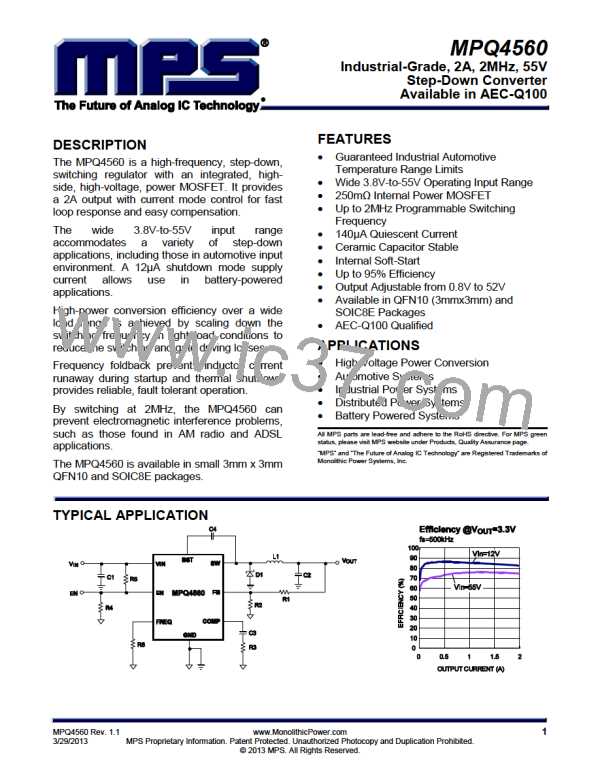MPQ4560 – 2A, 2MHz, 55V, STEP-DOWN CONVERTER
Input Capacitor
VOUT
VOUT
ΔVOUT
1
RESR
The input current to the step-down converter is
discontinuous and requires a capacitor to supply
the AC current to the step-down converter while
maintaining the DC input voltage. Use capacitors
with low equivalent series resistances (ESR) for
the best performance. Ceramic capacitors are
best, but tantalum or low-ESR electrolytic
capacitors may also suffice.
fS L
VIN
The characteristics of the output capacitor also
affect the stability of the regulation system. The
MPQ4560 can be optimized for a wide range of
capacitances and ESR values.
Compensation Components
MPQ4560 employs current-mode control for easy
compensation and fast transient response. The
COMP pin controls the system stability and
transient response. The COMP pin is the output
of the internal error amplifier. A series capacitor-
For simplification, choose the input capacitor with
an RMS current rating greater than half of the
maximum load current. The input capacitor (C1)
can be electrolytic, tantalum, or ceramic.
resistor
combination
sets
a
pole-zero
When using electrolytic or tantalum capacitors,
place a small, high-quality, ceramic capacitor
(0.1μF) as close to the IC as possible. When
using ceramic capacitors, make sure that they
have enough capacitance to provide sufficient
charge to prevent excessive voltage ripple at the
input. The input voltage ripple caused by
capacitance is approximately:
combination to control the control system’s
characteristics. The DC gain of the voltage
feedback loop is:
VFB
AVDC RLOAD GCS AVEA
VOUT
Where
AVEA is the error-amplifier voltage gain,
400V/V;
ILOAD
VOUT
VOUT
VIN
1
fS C1
VIN
V
IN
GCS is the current-sense transconductance,
5.6A/V; and
Output Capacitor
The output capacitor (C2) maintains the DC
output voltage. Use ceramic, tantalum, or low-
ESR electrolytic capacitors. Low-ESR capacitors
are preferred to keep the output voltage ripple
low. The output voltage ripple can be estimated
as:
RLOAD is the load resistor value.
The system has two important poles: One from
the compensation capacitor (C3) and the output
resistor of error amplifier, and the other due to
the output capacitor and the load resistor. These
poles are located at:
VOUT
VOUT
VIN
1
RESR
VOUT
1
fS L
8 fS C2
GEA
fP1
2πC3 AVEA
Where L is the inductor value and RESR is the
ESR value of the output capacitor.
1
fP2
For ceramic capacitors, the capacitance
dominates the impedance at the switching
frequency and contributes the most to the output
voltage ripple. For simplification, the output
voltage ripple can be estimated by:
2πC2RLOAD
Where,
transconductance, 120μA/V.
GEA
is the error-amplifier
The system has one important zero due to the
compensation capacitor and the compensation
resistor (R3). This zero is located at:
VOUT
VOUT
ΔVOUT
1
8 fS2 L C2
V
IN
1
For tantalum or electrolytic capacitors, the ESR
dominates the impedance at the switching
frequency. For simplification, the output ripple is
approximately:
fZ1
2πC3R3
MPQ4560 Rev. 1.1
3/29/2013
www.MonolithicPower.com
MPS Proprietary Information. Patent Protected. Unauthorized Photocopy and Duplication Prohibited.
© 2013 MPS. All Rights Reserved.
14

 MPS [ MONOLITHIC POWER SYSTEMS ]
MPS [ MONOLITHIC POWER SYSTEMS ]